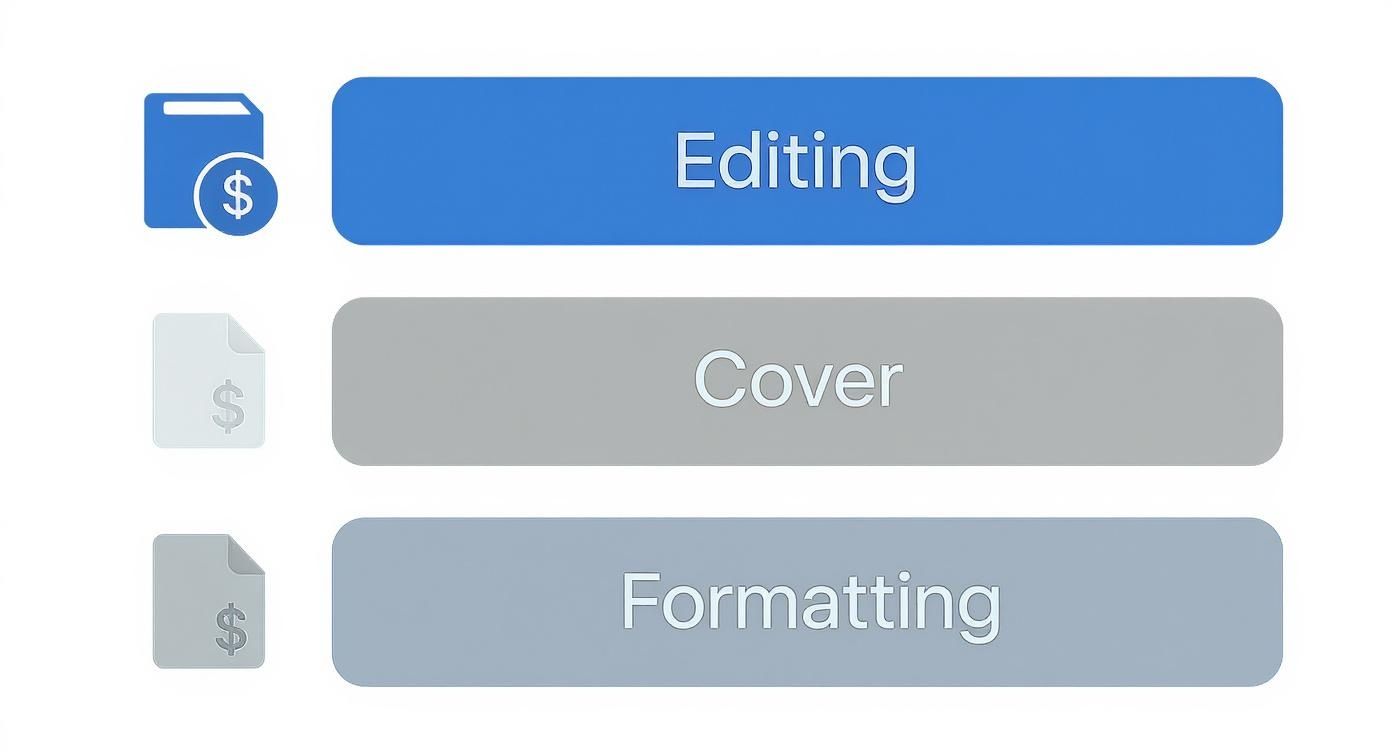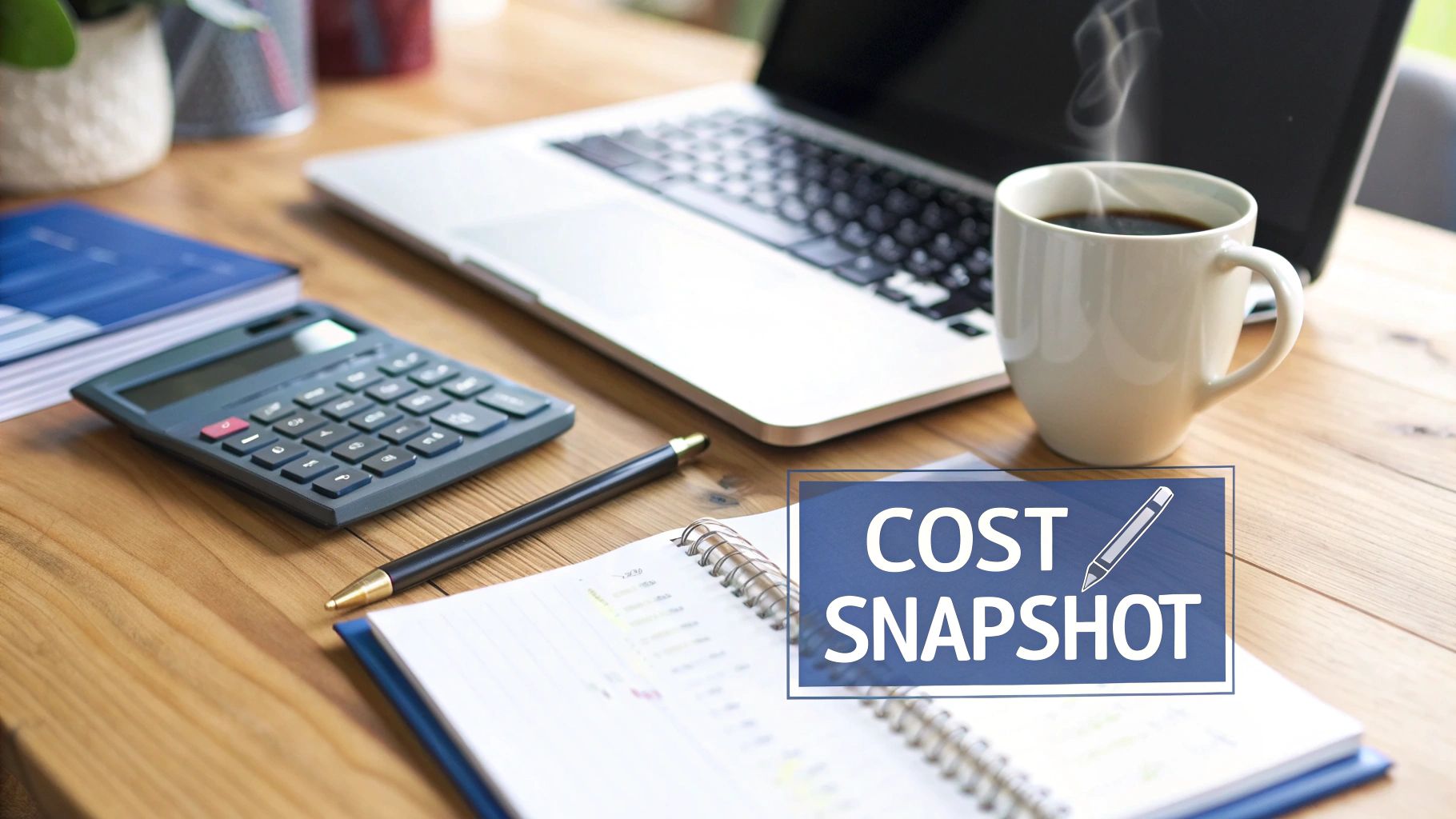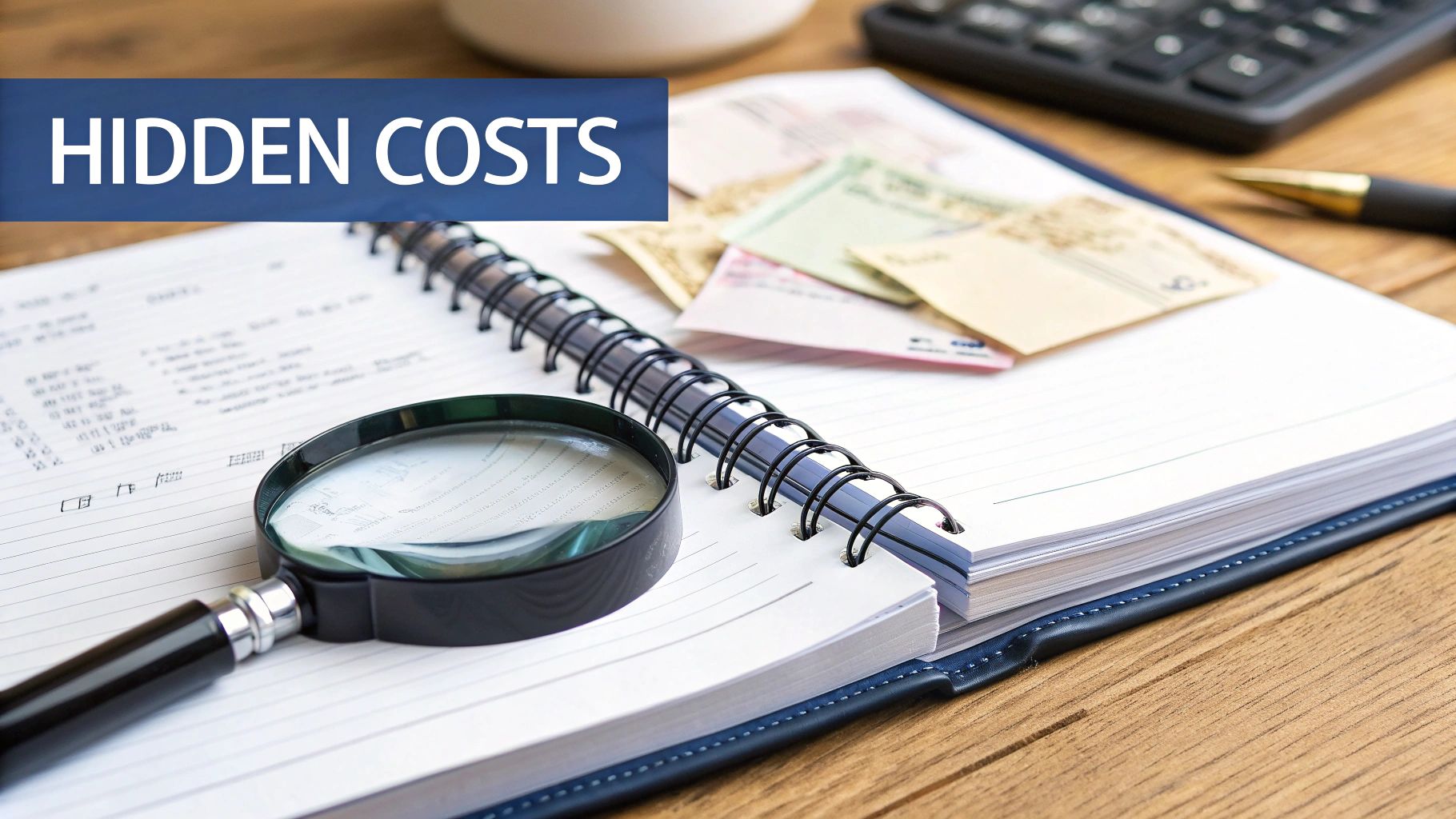So, you're ready to publish your book. The big question on every author's mind is: how much is this actually going to cost me?
The truth is, the total self publishing cost can be anything from a few hundred dollars to well over $10,000. It all comes down to the choices you make. Think of it less like an expense and more like a strategic investment in your book's future. The more you put into its quality, the better its chances are of succeeding.
A Quick Look at Your Potential Self Publishing Costs
Figuring out the money side of publishing can feel a little overwhelming at first, but it really boils down to one simple thing: deciding what you'll do yourself versus what you'll hire a professional for. Every service you choose, from a sharp-eyed editor to a brilliant cover designer, shapes both your budget and your book's market potential.
The whole process starts with getting a handle on the main cost drivers. It's a lot like budgeting for any other creative endeavor; in fact, looking at guides on understanding various project costs for things like websites can give you a good mental model for planning your finances.
Core Investment Areas
For any author serious about their craft, there are three areas you simply can't afford to skimp on: editing, cover design, and interior formatting. Each one is a critical pillar holding up your book's professional appearance. Cutting corners here is the fastest way to signal "amateur" to potential readers, and that can kill your sales before they even start.
This infographic gives you a great visual breakdown of where your money will likely go.

As you can see, editing often takes the biggest slice of the pie. There's a good reason for that—it's arguably the most important step in turning a good manuscript into a great book.
To give you a clearer picture, I've put together a quick table summarizing the typical cost ranges you can expect.
Quick Glance Self Publishing Cost Ranges
| Service | Low End (DIY/Budget) | Mid-Range (Professional) | High End (Premium) |
|---|---|---|---|
| Editing | $300 – $700 | $1,500 – $3,500 | $4,000+ |
| Cover Design | $50 – $250 | $400 – $1,200 | $1,500+ |
| Formatting | $50 – $150 | $250 – $800 | $1,000+ |
This table should help you get a ballpark idea of where your own project might land based on the level of professional help you're looking for.
Average Costs for a Standard Novel
Let's ground this with some real-world numbers. If you've written a standard 80,000-word novel, you can expect professional editing fees in 2025 to fall somewhere between $2,000 and $4,720. A professional cover design will likely set you back around $880, with interior formatting costing about $710. These figures give you a solid, realistic starting point for your budget.
Remember, these costs are investments, not just expenses. A professionally edited and designed book is far more likely to attract positive reviews, build a loyal readership, and generate a return on your initial outlay.
Every author’s journey is different, and your final costs will reflect your unique goals and the resources you have available. For a much more granular breakdown, be sure to check out our complete guide on the full cost to publish a book.
The Four Core Investments for Every Author
When you're trying to figure out your total self-publishing cost, it helps to think of it like building a house. You'd never pour a fortune into beautiful interiors if the foundation was shaky, right? The same logic applies to your book. Every professionally published book—the kind that readers love—is built on four critical pillars.
This is where your budget really counts. Skimping on any of these areas is a gamble, and it can sadly undermine all the blood, sweat, and tears you've poured into your manuscript.

1. Professional Editorial Services
Let's stick with the house analogy. Editing is the structural foundation. It's what makes sure your story is solid, your arguments hold water, and your sentences are clean and polished. A manuscript full of typos or glaring plot holes is like a house with a cracked foundation—it simply won't stand up to reader scrutiny.
The editing process isn't just one step; it has several crucial layers:
- Developmental Editing: This is the blueprint phase. A developmental editor looks at the big picture—your book's structure, plot, character arcs, and pacing—to ensure the core story is compelling from start to finish.
- Copy Editing: Now we're getting down to the sentence level. A copy editor is your master craftsperson, polishing your prose, improving clarity, fixing grammar, and ensuring your voice is consistent.
- Proofreading: This is the final walkthrough before you hand over the keys. A proofreader hunts down any sneaky typos, punctuation errors, or formatting glitches that made it through the other stages.
For any author who's serious about their work, investing in professional editing is non-negotiable. If you want to dive deeper, you can learn more about how much professional book editing costs in our detailed guide.
2. High-Quality Cover Design
Your book cover? That's the curb appeal. It's the very first thing a potential reader sees, and let's be honest, we all judge a book by its cover. A cheap or amateurish design will cause readers to scroll right on by, no matter how brilliant the story is inside.
A truly effective cover does three things almost instantly:
- Grabs Attention: It has to pop, especially as a tiny thumbnail on an Amazon page.
- Signals Genre: It immediately tells readers if they're looking at a thriller, a romance, or a sci-fi epic.
- Creates Intrigue: It makes someone stop, click, and want to know more.
A professional cover isn't just an expense; it's a powerful marketing tool. Time and again, data shows that a well-designed cover can dramatically boost a book's visibility and sales.
3. Clean Interior Formatting
If the cover is the outside of your house, the interior formatting is the clean, welcoming layout inside. This is the process of typesetting your manuscript for both print and ebook formats, creating a smooth and enjoyable reading experience.
Nothing pulls a reader out of a story faster than bad formatting—wonky fonts, weird spacing, or a messy table of contents. Professional formatting makes your book look just as polished as one from a major publisher, which builds trust and encourages those all-important positive reviews.
4. Strategic Book Marketing
Finally, marketing is the open house. You’ve built a fantastic, beautiful home—now you need to invite people in to see it! Without marketing, even the most incredible book will sit on a digital shelf, completely undiscovered.
This investment covers a huge range of activities, from building an author website and running social media ads to growing an email list and getting your book into the hands of bloggers. A real marketing plan is what helps you find your audience and turn them into fans.
These four pillars—editing, cover design, formatting, and marketing—are the absolute essentials. They form the core of any successful self-publishing budget.
Choosing Your Publishing Path
Figuring out your self-publishing cost isn't about landing on a single magic number. It's really about choosing a path—one that aligns with your specific goals, skills, and, of course, your wallet. Every author is juggling the same three resources: time, money, and skill. How you decide to balance them will shape your entire publishing journey.

Fundamentally, you have two main roads you can take. Each comes with its own set of very real trade-offs. Getting a handle on these paths is the first, most crucial step in building a budget that actually works.
The Bootstrapper's Path (DIY)
This is the path for the author who has more time on their hands than cash in the bank. The mindset is simple but powerful: if you can learn to do it, you do it yourself. This approach can slash the upfront financial cost to near zero, opening the door to publishing for just about anyone.
Going DIY means you'll be wearing a lot of hats. You'll become the cover designer, learning the ropes on free tools. You'll be the book formatter, wrestling with software to get your manuscript just right. You'll lean heavily on beta readers and your own editing skills to polish the story. The savings are huge, but don't underestimate the trade-off—it demands a massive amount of your personal time and a willingness to climb a steep learning curve.
The DIY route is an incredible way to get your book out into the world on a shoestring budget. Just be honest with yourself about the final quality. A homemade cover or an unpolished edit can sometimes scream "amateur" to potential readers.
The Professional Investor's Path
This route is for authors who treat their book like a business launch. On this path, your time is the most precious resource, so you invest money to buy it back and ensure the highest possible quality. You're not the jack-of-all-trades; you're the CEO of your book, hiring a team of experts for each critical step.
Instead of sinking weeks into learning design theory, you hire a professional cover artist who lives and breathes it. Rather than fighting with formatting glitches, you pay an expert to make your interior look flawless. You invest in multiple rounds of professional editing to make sure your manuscript is as clean and compelling as it can be. This path requires a much bigger upfront budget, but it dramatically shortens your timeline and elevates your book to a professional, industry-standard level.
DIY vs Professional Services A Cost and Quality Comparison
To make the decision a bit easier, it helps to see the trade-offs laid out side-by-side. Think of this table as a snapshot of the choices you'll be making for the most critical parts of the publishing process.
| Task | DIY (Do-It-Yourself) Approach | Professional Service Approach | Key Consideration |
|---|---|---|---|
| Editing | Relying on beta readers, critique partners, and self-editing tools like ProWritingAid. Minimal to no cost. | Hiring developmental, copy, and proofreading editors. Costs $1,500 – $4,000+. | Quality vs. Cost: Professional editing is often the single most important investment for a book's long-term success. |
| Cover Design | Using free software like Canva or buying a cheap pre-made cover. Costs $0 – $100. | Commissioning a custom cover from a professional designer. Costs $400 – $1,500+. | Marketability: A professional cover is your #1 marketing tool. It directly impacts clicks, impressions, and sales. |
| Formatting | Learning to use software like Vellum or the free Reedsy Book Editor. Costs $0 – $250. | Hiring a professional formatter for print and ebook versions. Costs $250 – $800. | Reader Experience: Poor formatting is distracting, looks unprofessional, and can lead to frustrated readers and bad reviews. |
In the end, this choice is about more than just the initial self publishing cost. It's about finding the right alignment between your budget, your goals, your skills, and the amount of time you can truly commit to bringing your book to life.
Looking Beyond the Big Three: What Else Do You Need to Budget For?
When authors map out their self-publishing costs, they almost always account for the big three: editing, cover design, and formatting. But if you stop there, you're setting yourself up for some nasty surprises down the road. Several other expenses are lurking just around the corner, and they can easily throw a carefully planned budget into chaos.
Think of it like buying a house. You budget for the mortgage, but what about property taxes, insurance, or that leaky faucet you didn't notice during the walkthrough? The same principle applies here. To ensure a smooth launch, you need to account for everything, not just the obvious stuff.
Setting Up Your Author Business
Some of the most critical investments you'll make aren't even for the book itself. They're about building the professional foundation for your author career. Getting these sorted early prevents last-minute scrambles and sets you up for long-term success.
Here are a few of the most common costs that catch authors off guard:
-
Your Own ISBNs: Sure, Amazon will give you a "free" ISBN, but it comes with a major string attached—it locks your book to their platform. To be the true publisher of your work and have the freedom to distribute it anywhere, you need to buy your own. A block of 10 ISBNs runs about $295, and it's a non-negotiable for serious authors who want full control.
-
Author Website & Email List: Your website is your home base online, the one piece of digital real estate you truly own. You'll need to budget for a domain name (usually $10-$20 per year), web hosting ($60-$300 a year), and an email marketing service to start building that all-important connection with your readers.
An author website isn't a "nice-to-have"—it's an essential marketing tool. It’s the only place you can interact with your audience directly, without a social media algorithm deciding who sees your posts.
Other Potential Investments to Consider
As you get further into your author journey, other expenses might pop up. You won't necessarily need these for your very first launch, but it's smart to keep them on your radar.
- Software Subscriptions: Many writers rely on specialized tools for drafting, editing, or design, and many of these come with monthly or annual fees.
- Professional Author Headshots: A polished, high-quality photo of yourself builds credibility and is a must-have for your website, social media profiles, and any press materials.
- Audiobook Production: This is a big one. Tapping into the booming audiobook market is a fantastic way to reach new readers, but professional narration and production can easily cost $2,000-$4,000.
By planning for these "hidden" costs from the beginning, you create a much more realistic budget. This kind of foresight is what separates a stressful, chaotic launch from a smooth, successful one, turning your publishing expenses into a smart investment in your career.
Is the Investment in Self-Publishing Worth It?
After looking at all those potential expenses, you're probably wrestling with the big question: what’s the actual payoff? It's easy to get bogged down by the self-publishing cost, but the real story—the exciting part—is your earning potential.
One of the biggest draws for indie authors is the royalty structure. Seriously, it’s a game-changer. On a platform like Amazon KDP, you can keep up to 70% of your ebook's sale price. Compare that to the standard 10-15% you might see in a traditional publishing deal, and you can see why so many authors are making the switch. That higher percentage means you earn back your investment much, much faster.

The data speaks for itself. This screenshot shows a clear upward trend in the income reported by self-published authors. While success is never guaranteed, it drives home the point that real, substantial earnings are not only possible but are becoming more common for authors who take control of their careers.
Connecting Investment to Income
Think of your upfront investment as a direct line to your long-term earnings. Every dollar you put into making your book professional isn't just a cost—it's a tool that actively works to sell your book for you.
- Professional Editing: A clean, polished book gets good reviews. It’s that simple. Readers have no problem leaving a one-star review for a book riddled with typos or plot holes, and those negative comments can kill your book's momentum before it even starts.
- Captivating Cover Design: Your cover is what makes someone stop scrolling. It’s your most powerful piece of marketing, and it’s the single biggest factor in getting that first click.
Good reviews and more clicks lead directly to more sales. That's how you transform those initial expenses into a reliable income stream.
Let's talk numbers. The financial returns can be significant. One 2022 report found the median income for self-published authors hit $12,749, which was a huge 53% increase from the previous year. The mean income? Over $82,600. This data comes from the Alliance of Independent Authors, and it really highlights that self-publishing can be a viable career when you treat it like a business.
If you're still weighing the pros and cons, we've got a much deeper dive into this topic. You can explore our detailed article on https://barkerbooks.com/is-self-publishing-worth-it/.
Maximizing Your Sales Potential
Of course, putting a fantastic book out into the world is only step one. The real return on your investment comes when people actually buy it, and that means marketing. Platforms like Amazon are crowded, so getting your book seen is everything.
To make your investment truly pay off, you have to learn how to sell. It's a skill, just like writing. For a solid starting point, check out these strategies to improve Amazon sales and learn what it takes to stand out. At the end of the day, the worth of your investment isn't just measured in the number of books you sell, but in the sustainable career you build as an author.
Common Questions About Self-Publishing Costs
Alright, let's get into the questions that are probably swirling around in your head. Thinking about the budget for your book can feel a little overwhelming, but getting straight answers is the best way to move forward with confidence.
Here are some no-nonsense answers to the most common things authors ask about the financial side of self-publishing.
Can You Actually Self-Publish a Book for Free?
The short answer is yes, you can publish a book for $0. Platforms like Amazon's Kindle Direct Publishing (KDP) don't charge a fee to upload your files and put your book on their virtual shelves. You could try designing your own cover with free tools and just edit the manuscript yourself.
But "free" almost always comes at a different kind of cost. Without a professional edit or a cover that actually grabs a reader's attention, your book is going to have a hard time standing out. Readers can spot an amateur-looking book from a mile away, and most will simply scroll past it, which means you'll likely see very few, if any, sales.
What Is a Realistic Budget for a First-Time Author?
If you're a first-time author who's serious about putting out a quality book, a realistic budget usually lands somewhere between $2,000 and $5,000. This is a solid range that covers the absolute essentials: high-quality editing, a professional cover design, and clean, readable interior formatting.
Your budget is a direct reflection of your goals. If you see your book as a professional product and a potential business, investing in its quality is the smartest move you can make.
Think of it as an investment. Spending money on these core services gives your book a real fighting chance against traditionally published titles and helps you start earning back your initial costs.
Where Should I Spend My Money If I Can Only Afford One Thing?
This one is easy. If your budget is stretched thin and you can only pay for one service, make it editing. Hands down, a great editor is the single most critical investment for your book's long-term success.
A killer cover might get someone to click, but it can't save a story riddled with typos, plot holes, or clunky sentences. A polished, well-edited manuscript is what earns you good reviews, and good reviews are the best marketing tool on the planet. A smooth reading experience builds trust with your audience and gets them talking.
Is Self-Publishing Growing in Popularity?
Absolutely. The self-publishing world has exploded in recent years. Its growth rate is actually outpacing many other industries, which is pretty amazing when you think about it. This boom is all thanks to platforms that let authors skip the traditional gatekeepers and connect directly with readers all over the globe. If you want to dive into the numbers, you can explore the full self-publishing market report.
What this growth means for you is that there are more tools, more talented professionals, and a bigger community of authors to support you than ever before. You’re joining a massive, and rapidly growing, movement of entrepreneurial writers. Ultimately, being smart and strategic about your self-publishing cost is what will set you up for a great launch and a rewarding career.
Ready to turn your manuscript into a professionally published book that reaches readers worldwide? The expert team at BarkerBooks is here to guide you through every step, from editing and cover design to global distribution and marketing. Learn more and start your publishing journey with BarkerBooks today!
